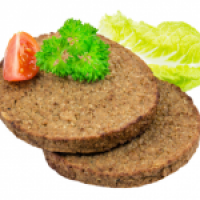Modern Wheat is Making You Sick

If you are reading this article, you probably got here by asking the question, “Is wheat bad for you?” Do you know people who avoid eating wheat? Most of us do, but why are they doing it?
Whether they avoid it because they are gluten-intolerant, have celiac disease, or are on a low-carb diet, the number of people who avoid eating wheat is growing. The reason? Modern wheat is bad for you.
But I Eat Whole Grain Wheat!
You are probably wondering to yourself is all wheat the same? I eat whole-grain wheat. You have heard for years that you should eat “whole grains” instead of highly processed breads, right? And, like me, you heeded that advice of stocking up on 12-grain bread because you knew that whole-grain bread contained more thiamin, niacin, and iron than white bread. The problem is that no matter how unrefined or whole grain our bread and pasta may be, it does not change the fact that wheat is bad for you.
What Is Whole Grain Wheat?
Let’s take a minute to consider what is meant by “whole grain wheat.” The term refers to the parts of the wheat grain that are contained in a product. Grains contain three main parts: the germ, the endosperm, and the bran.
When grains are “refined,” the germ and bran are removed. This is achieved through grinding, sifting, mixing, bleaching, and brominating using potassium bromate, a cancer-causing chemical that often remains in the final product.
If you are a health-conscious individual, it makes sense that you would buy whole-grain wheat, which is clearly a nutritionally superior product. Like me, you probably thought that by choosing a whole-grain bread, you would be healthier and probably stand to be a bit trimmer than those people who eat the nice, fluffy, spongy white bread. Wrong.
While whole grain wheat is nutritionally superior to refined wheat products, there is more to the story that might just make you rethink whether or not you should consume wheat.
What You DON’T Know About Wheat
There is something about wheat that you probably don’t know – and that is what makes wheat bad for you. The wheat that is on the shelves of grocery stores today is not the same wheat that our grandparents ate. The wheat we eat today, “Modern Wheat,” is a recent hybrid that has been developed over the last 60 years.
Since the 1950s, scientists have genetically altered wheat to be more productive and resistant to weather and pests. These genetic alterations have added extra chromosomes to wheat. The original wheat, Einkorn, has only 14 chromosomes. Modern Wheat, by comparison, has 42 chromosomes.
Why so many extra chromosomes? Wheat is unique because it can add additional chromosomes when crossed with another similar plant. Most other species on earth retain the exact same number of chromosomes when they reproduce, which is one way in which we can identify a species.
That means “Modern Wheat” is not the same as traditional wheat – like what your grandparents ate. It is a new species altogether.
Why Modern Wheat Is Bad for You
Modern Wheat has a number of problems, from its DNA to its effect on blood sugar. Whether found in expensive whole-grain breads or the refined variety like you find in Ho-Ho’s, modern wheat has a serious impact on the human body.
Gluten
Let’s start with gluten since most of us know the “gluten-free” trend. Gluten is a lectin that gives dough its elastic texture. Anyone who has ever baked bread is familiar with the distinctive goofy yet elastic texture that dough forms when it rises.
The gluten found in Modern Wheat owes much of its DNA to one of the goat grasses with which traditional wheat was crossed. This DNA was desirable because it gives Modern Wheat the elasticity and pliability we just discussed. It also causes dough to rise much better than traditional wheat.
What Does Modern Wheat Gluten Do to Us?
One of the current theories about why so many people have developed celiac disease (a very serious wheat-specific condition) or an intolerance to wheat is since our bodies are not used to processing Modern Wheat which has only been around for 50 years or so.
On a cellular level, our bodies simply don’t recognize this new grain species. Some people’s bodies react by critical tissue dying off in the small intestine. This is what happens in celiac disease. This intestinal die-off keeps the body from absorbing nutrients and people with celiac become malnourished as a result.
In other people, their bodies simply have a hard time digesting it, leading to gas, constipation, and diarrhea. Yet, others have no gastrointestinal symptoms but instead suffer from “brain fog,” dizziness, and inflammation, resulting in widespread pain (often leading to fibromyalgia or chronic fatigue syndrome diagnoses) and migraines.
Even more frightening than the aforementioned conditions is the number of auto-immune diseases that apparently have some link to Modern Wheat gluten. While not yet formally listed as a cause of these diseases, many people with these conditions report significant improvement of their symptoms when they eliminate gluten from their diet. Lupus, scleroderma, psoriasis, rheumatoid arthritis, ulcerative colitis, Hashimoto’s thyroiditis, and multiple sclerosis are all conditions that can be improved by removing gluten from the diet.
Some researchers argue that the cause of these ailments is that the human body hasn’t had time to adapt adequately to the original grains we began consuming between 7,000 – 11,500 years ago, let alone Modern Wheat. And this doesn’t even begin to scratch the surface of the various mycotoxins that can come into our bodies by consuming mass-grown modern wheat that often grows molds during processing.
How Wheat Makes Us Fat
Would it surprise you to learn that two slices of whole wheat bread can raise your blood sugar more than 6 teaspoons full of sugar or a Snickers candy bar? It’s true.
How is that possible, you ask? Well, it’s due to the fact that Modern Wheat contains a very large amount of something called Amylopectin-A. Amylopectin-A is a starch that breaks down very rapidly in digestion causing blood sugar to skyrocket.
The Problem With Spiking Blood Sugar
When our blood sugar rises very rapidly, our bodies secrete large amounts of insulin to bring our blood sugar levels down quickly. High blood sugar (hyperglycemia) is very dangerous and can be fatal it it becomes high enough.
Our bodies are doing their job by tackling the rising blood sugar quickly, but what happens as a result is harmful to our health. Insulin’s job is to get the sugar into our cells. You could think of insulin being like a key to a lock on the cells. It opens the door and lets the sugar inside. This is a normal function, but it goes a bit haywire when too much sugar is present – especially if it happens often, and it does if you are eating the Standard American Diet (SAD), which contains tons of Amylopectin-A-laden wheat.
An overabundance of sugar in the blood becomes visceral fat, the fat around our abdomens. Visceral fat is unique in that it causes a wide range of inflammatory conditions, high levels of estrogen and insulin, and puts people at a much higher risk for diabetes and heart conditions.
Amylopectin-A, the quickly digesting starch in wheat, not only causes high blood sugar spikes that lead to the formation of visceral fat, but it also causes a condition known as insulin resistance. Insulin resistance is the condition that comes before a diagnosis of “pre-diabetes.”
Remember the analogy of insulin being the key to let glucose into cells? In insulin resistance, it is like some of the locks on the cells have changed just a bit so that they keys (insulin) don’t work as well. This means the sugar floating around in the blood stays high.
Detecting the still high blood sugar levels, the body pumps out more and more insulin to try to drop the blood sugar level. Over time, the cells that produce insulin become exhausted and can no longer keep up with the constant high need for insulin. This is when a person becomes pre-diabetic and eventually Type 2 diabetic.
The Standard American Diet (SAD) is permeated with wheat, and it is hard to escape it. The sinister thing about wheat is that when we eat it, it makes us crave more of it.
Ever wonder why many restaurants give you free bread to begin your meal – before you order? It isn’t an accident. Blood sugar can spike in a matter of minutes, and your brain has been conditioned that this is a good thing. It makes you much more likely to order more food – and probably a dessert later. Why? Because your brain is releasing dopamine, a feel-good hormone, which is telling your brain that an instant spike in blood sugar is good – get more!
Restaurants are using our addiction to sugar to make us spend more just by giving us free Amylopectin-A laden wheat products. Sound like drug dealers? “First one’s free”.
Beware of Gluten-Free Foods
In our rush to avoid Modern Wheat and gluten, we are apt to grab a box of pasta or cookies labeled “gluten-free,” thinking that this is a better choice. Unfortunately, food manufacturers caught onto the whole gluten-free movement and started trying to capture market share before people found healthy alternatives.
“Gluten-free” does not mean healthy. Many, if not most, products that bear the “gluten-free” label are just as bad for you, if not worse. They are full of rice flour, potato flour, tapioca starch, and corn starch. Much like Amylopectin-A, these starches are quickly broken down in the body and spike blood sugar.
Just as with Amylopectin-A, the rise in blood sugar from these gluten-free alternative foods brings about problems such as insulin resistance, intense food cravings, and chronic diseases such as heart disease.
So, If Wheat is Bad, What Should I Eat?
Now that you know about the unhealthy aspects of Modern Wheat and many “gluten-free” labeled wheat alternatives, what do you do? It sounds like there’s nothing left – no wheat, potatoes, rice, or tapioca…
Fortunately, there are several products on the market that you can use as healthy wheat alternatives. Most major grocery stores carry them. You can often find them in the specialty aisles.
Venture outside your normal path through the grocery store and start looking for these items: quinoa, flax seed, flax seed meal, ground pecans, ground walnuts, almond meal, almond flour, yucca, sesame seed meal, amaranth, coconut flour, pumpkin seed meal, chia seed meal, and garbanzo bean flour, just to name a few.
Don’t have any idea how to cook them? No problem. Just google them, and you will find more recipes than you can cook in a lifetime. If you feel overwhelmed by the sheer number of possibilities, try saving recipes that sound interesting to Pinterest or Evernote and organize them like you would a traditional recipe book. That way, you can pull them up on your phone when you are shopping.
References
-
Fasano, Alessio. “Surprises from Celiac Disease.” Scientific American, Jan. 2009, www.scientificamerican.com/article/surprises-from-celiac-disease/. Accessed 29 June 2024.
-
Guandalini, Stefano, and Drago, Severino. “Celiac Disease and Gluten Sensitivity.” Journal of Pediatric Gastroenterology and Nutrition, vol. 55, no. 4, 2012, pp. 457-460. www.ncbi.nlm.nih.gov/pmc/articles/PMC3730481/. Accessed 29 June 2024.
-
Sapone, Anna, et al. “Divergence of Gut Permeability and Mucosal Immune Gene Expression in Two Gluten-associated Conditions: Celiac Disease and Gluten Sensitivity.” BMC Medicine, vol. 9, no. 1, 2011, www.ncbi.nlm.nih.gov/pmc/articles/PMC3118977/. Accessed 29 June 2024.
-
Davis, William. “Wheat Belly: An Analysis.” Examine.com, www.examine.com/nutrition/wheat-belly/. Accessed 29 June 2024.
-
Holland, Stephanie. “Wheat and Other Grains in Relation to Health: Celiac Disease, Autoimmune Diseases, and Nutritional Considerations.” Journal of the American College of Nutrition, vol. 38, no. 3, 2019, pp. 188-192. www.ncbi.nlm.nih.gov/pmc/articles/PMC6595631/. Accessed 29 June 2024.
-
Atkinson, Fiona S., et al. “International Tables of Glycemic Index and Glycemic Load Values: 2008.” Diabetes Care, vol. 31, no. 12, 2008, pp. 2281-2283. www.ncbi.nlm.nih.gov/pmc/articles/PMC2584181/. Accessed 29 June 2024.
-
Hadjivassiliou, Marios, et al. “Gluten Sensitivity: From Gut to Brain.” The Lancet Neurology, vol. 9, no. 3, 2010, pp. 318-330. www.ncbi.nlm.nih.gov/pmc/articles/PMC2845795/. Accessed 29 June 2024.
-
Scher, Jose U., and Abramson, Steven B. “The Microbiome and Rheumatoid Arthritis.” Nature Reviews Rheumatology, vol. 7, no. 10, 2011, pp. 569-578. www.nature.com/articles/nrrheum.2011.121. Accessed 29 June 2024.
-
Sollid, Ludvig M., and Jabri, Bana. “Is Celiac Disease an Autoimmune Disorder?” Current Opinion in Immunology, vol. 27, 2014, pp. 61-67. www.ncbi.nlm.nih.gov/pmc/articles/PMC4318496/. Accessed 29 June 2024.




